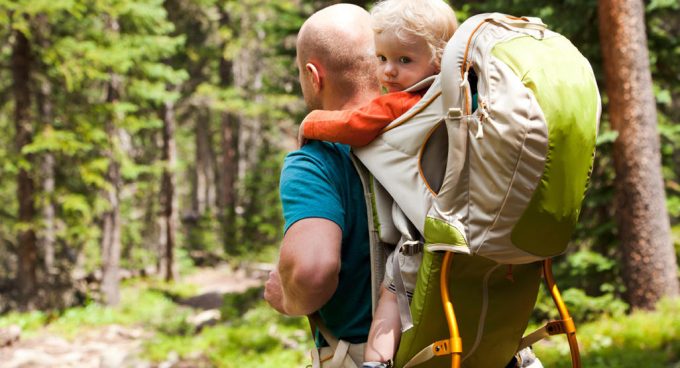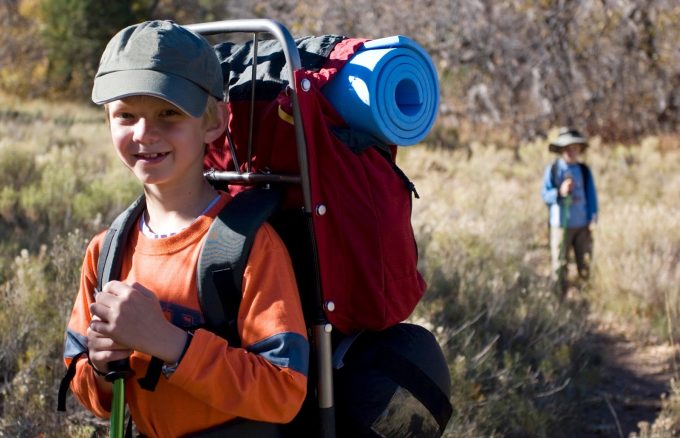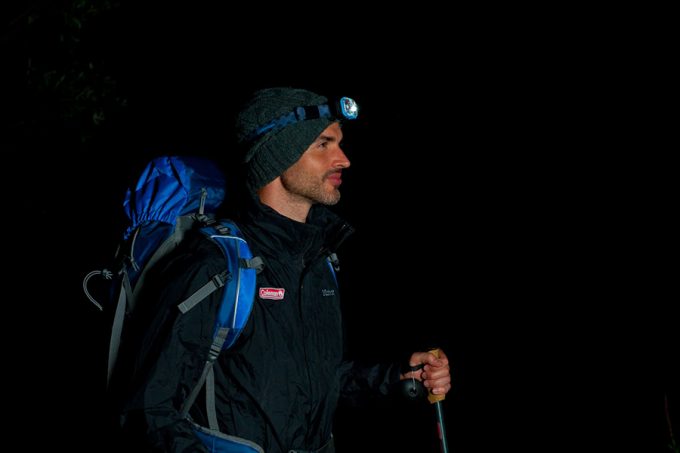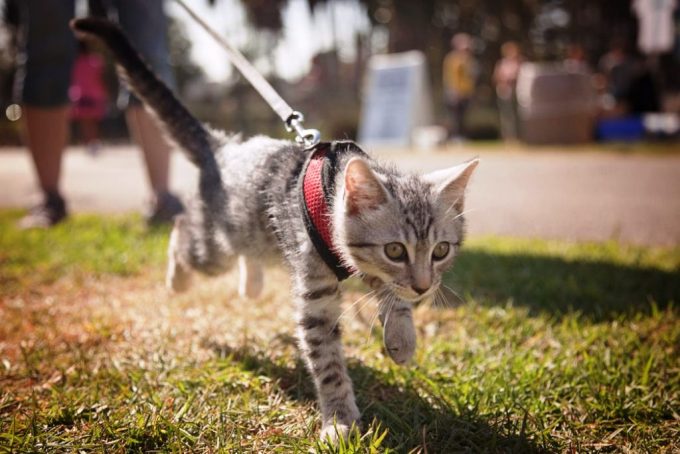Hiking with Kids: Introducing the Nature Early
Hiking is a great way for many to fully enjoy the outdoors, get their stress levels back to normal and fully recharge their batteries. Many successful people take a regular trip to the woods that allows them to clear their mind and take time out of their busy schedules to enjoy themselves.
[the_ad_group id=”21″]
But, when it comes to hiking with kids, you can oftentimes wonder if those two things even go together, right? Well, it turns out – they easily can!

Of course, it would be a bit more challenging until you get the hang of it and the first couple of hiking trips might not go as planned concerning the length of the hike. However, there is absolutely no reason to stop enjoying your favorite hobby just because a new member has joined the family.
Even more so, introducing kids to nature early can only benefit them in the long run.It turns out that with just a bit more planning and some decent organizing skills,whole families can have awesome family days together and spend some quality time in nature away from phones and electronics.
Planning your hiking trip
It would be best to start thinking about what you need to do before the actual hike takes place. Thinkingabout every detail and planning way ahead is going to save you a lot of unnecessary trouble.
Take the age into account
It might not be a wise decision to go on a hike with a newborn. Newborns need some time to adapt to the outside world, they sleep a lot (and cry a lot!) and everyone in the family, especially the mother, need some time to recover and adjust to the new addition. You might want to postpone until the baby has reached at least three months of age and has some sort of a sleeping and eating schedule.

Other than that, taking age into account is especially important with toddlers and young children, so you can plan all of the necessary equipment you’ll need to help you carry the child. Do check out our tips on camping with infants to help you with your little one.
3-12-month-olds should be carried in a front carrier, and science says it’s for the best if you carry them facing towards you. Toddlers (12-24 months), considering the fact that they weigh more, would be more comfortable in a back carrier. Even though it might sound shocking to some to carry your child on your front/back while pacing on a rocky terrain, people can sometimes forget that those little ones are quite tough!

Don’t worry about your child being distressed back there – experienced hikers report that often times, kids enjoy the swinging so much, they fall fast asleep.
When it comes to older children, starting from the moment when they start to walk properly, up to the age of 4 or 5, there’s not much you can do to make them sit still in a carrier or walk for hours straight. At this age, they are little explorers and everything is new and interesting. Your duty as a parent is to so allow them to be in an environment where they can safely inspect whatever is of interest to them.

However, do prepare yourself for more often than not, the thing of greatest importance will probably be a rock or a stick.
Hiking gear
Next thing that should be taken into consideration when planning the trip is the appropriate clothing. It might be a good idea to invest in some good hiking gear – maybe a top-notch windjacket and a pair of hiking boots. You can never go wrong with layering and that is the easiest way to regulate if someone is feeling too hot or too cold. Check out our expert review of the top hiking boots for kids to give you more options.
If kids are expected to walk great lengths (and don’t forget – what is considered normal for an adult is extreme for a child), ensure their shoes are comfortable. You should probably get them a waterproof pair since children do like water and mud puddles. Also, don’t forget to take an extra change of clothes for each child because days in nature usually end up with kids being dirty, sweaty and wet.

It is important to make sure everyone stays warm at all times. Don’t let sunny days fool you – even in summer, mornings can be quite chilly and a light jacket will do the trick.Afterward, if it’s light enough, it can be either packed in your backpack or put around their waist.
If your hiking trip is in the colder months, then it’s a must to get everyone a full winter gear.
[the_ad_group id=”22″]
It could be a potentially good idea to buy a full body, one-piece winter suit that is waterproof as well because that would enable your kids to move around freely and you wouldn’t have to worry about them getting cold or wet. Top that off with a warm winter hat and a pair of gloves and you’ll be ready to go.
Packing essentials for parents
Parents, when it comes to packing, tend to get carried away at times, even when it comes to day trips. Chances are, you will most likely not use everything you put in that oversized backpack and why walk around for the whole day with an extra weight on your back?
If you’re not new to hiking, you know the basic drill – a trail map, a compass, a flashlight and some first-aid supplies, alongside with some food and water.

However, when it comes to hiking with kids, the basics seem to change a bit.Start off by making a priority list so you don’t overdo it and end up with tons of unnecessary items.
Here is a basic list to help you out:
- Water, food, and snacks;
- First-aid kit;
- Diapers (if your child is still using them);
- Wet wipes and paper tissues;
- Sunscreen and bug repellent;
- Safety whistles for each child;
Don’t forget about food and water
Pack enough water, food and snacks for everyone. Once in nature, the fresh air does wonders and kids are going to get a bigger appetite. Make sure all of the packed meals are light and opt for something that doesn’t go bad easily – recommendations are to avoid using meat or meat products and are more on the fruit and vegetable side.
A vegetarian sandwich or a wrap could be a good idea since it will be packed and they won’t have to touch all of the food with their (most likely, dirty) hands.

You can get your kids a water bottle with their favorite cartoon hero or put some stickers to personalize it further more. That’s one way to make sure they’ll carry it around with them and drink water without being forced to.However, pay attention to not get a huge bottle because it might be too heavy when filled with water. If your child is still being breastfed, then make sure you are the one who stays hydrated enough during the day.
First aid
A basic first-aid kit can be bought in almost every pharmacy and it might come in handy when you at least expect it. In case you forgot to grab one, get some band aids, some sterile bandages, a disinfectant and a pair of tweezers and put them in a clean container. For more information on the best first aid kits, see our earlier article on this.

You’ll be surprised how often kids get a prickle in their finger or how a blister can pop in the most unexpected of places.
What else?
Make room for some wet wipes and paper tissues, alongside with diapersif your child is still using them. You probably won’t be able to keep everything clean due to the fact that there will be a lot of running around and dirt touching, but they can at least wipe hands before their snack.
Sunscreen and bug repellent are a must; the sun can be pretty strong up in the mountains and children’s skin is sensitive so take good care as to not end up your hiking trip with sunburns. As far as bug repellent goes, it is enough to have one disastrous accident with a small bug that will put off your child from hiking for a long time.

Last but not least, a safety whistle. The rule goes that if your child is old enough to walk on their own, then they should get a safety whistle. Do yourself a favor and buy some cheap, colorful whistles that can be put around the neck (maybe even put some stickers on them as well). Instruct each child how to use it in the case of emergency. For example, they can blow the whistle three times if they are lost or two times if they’re in danger.
Choice of location
The biggest dilemma most parents face is where to actually take their kids for their first hike ever. The majority of experienced hikers have their favorite trails and that’s for a reason – those are often times further away from the cities and higher up in the mountains. Some even require a couple of hours in the car just to reach the start of the hiking path.
Even though you might want to take your kid to your favorite location and make them fall in love with the awesome sight – just as you did! – it might be for the best to leave that part for later on. A two or three-hour car drive and a day-long hiking trip could prove too much for every child and it could ruin a potentially fun day.

When heading out with your kids for the first couple of times, don’t go too far. In this case, less is more, meaning that it is going to be better if you stay closer to home. Pick a wood close to town or some sightseeing sight near your house – everything that will sound as a thrill to your kids. Some even choose to do their first hike in the hills at the back of their house. That way, if something goes wrong, they can easily get back.
Another good idea is to consider which location might offer an element your child will enjoy. Children won’t get especially excited about seeing trees or rocks, so try to get them into the hiking mood by getting them thrilled about something. Water usually works well here.
Choose a location that has a waterfall at the end of the hiking pathor a pond full of fish. That willmake them eager to reach the end of the hiking pathand give them something to talk about on their way back.

Of course, this goes without saying that it’s meant more towards older children, not babies and toddlers. As far as toddlers go, they will be perfectly happy to spend their whole day picking flowers or rocks from the ground. This means that anice back carrier and a soft, grass-filled meadow works best for them.
However, be careful to supervise no matter how naïve the activity might look – they couldputsomething in their mouth that they’re not supposed to or wander off.
Word of precaution
Planning the first family hiking trip is not easy. Being able to genuinely impress children, even when it comes down to your own is often times more difficult than anticipated. To make sure things go as smooth as possible and in order to avoid some major catastrophe, read a few words of precaution.
Seems like the sanest word of advice out there is – you can never be careful enough while hiking with kids! An average trail for a grown up is a literal battlefield for the child. They might trip and fall or wander off faster than you think. Also, check the trail and make sure it’s not wet or slippery for the most part nor choose something that is extremely rocky. It wouldn’t be safe to do it eitherif you carry a baby on your back as you may easily slip and fall with the added weight.

Another point there is that hiking with kids goes slow enough on its own, so imagine how long it will take if you have to do it on bad terrain.
On top of that,it is important to not expect to go more than a couple of miles at best if you’re going with toddlers and a few miles if going with older children. It is very likely kids will get distracted and make short breaks every few steps, just because they saw a big butterfly or a weirdly shaped rock. Talking about breaks, you may want to introduce some as a parent every half an hour or so, and offer them snacks and drinks, keeping them less cranky and tired.
Some parents are reporting that their kids areresilient and refuse to go on a hike. You can solvethis problem by choosing a different name that sounds more appealing to them – an adventure, a mystery trip, a rock hunt, etc. You know your child best and choose something that would do the trick.

Some parents shared their experience that involving their favorite computer game hero in the story helped a lot. Also, talk about all the fun things you’re going to see – mushrooms, flowers, bugs, etc., the pictures you’re going to take and even offer a small reward or treat after the successful trip is done.
[the_ad_group id=”23″]
While adults who are nature-lovers have a blast, children have short attention spans and may get bored. A potential solution to this problem would be to play games, sing songs and even try marching on the trail!
If you feel you have enough energy to supervise another child, offer an older child to bring a friend. In a child’s point of view, adults are boring, but their friends are awesome and sharing an adventure with a friend will be something they’ll remember for sure.
Stay on the right path
Quite literally said when it comes to hiking, but metaphorically as well. When hiking, most adults have a pre-planned track and everything is running on a tight schedule in order to get back before nightfall. But when you’ve got some young hiking companions along your side, things change a bit. Even though the organizing element is the key one here, it applies more to the preparation of the hike and not the hike itself.

Giving yourself a bit of flexibility is much needed in this case. Relax as much as possible and focus more on the positive aspects of the day – bonding and quality time spent together. Be ready that things may not go as planned and look at the bigger picture. You want to slowly introduce your kids to nature and make sure they enjoy their time spent there.
No need to control everything, as long as everyone is safe and sound. Kids will be kids; let them run and get dirty and they’ll be completely satisfied. Think with the mind of a child and try to get down on their level. That way, everyone gets to have a blast and a day to remember.






